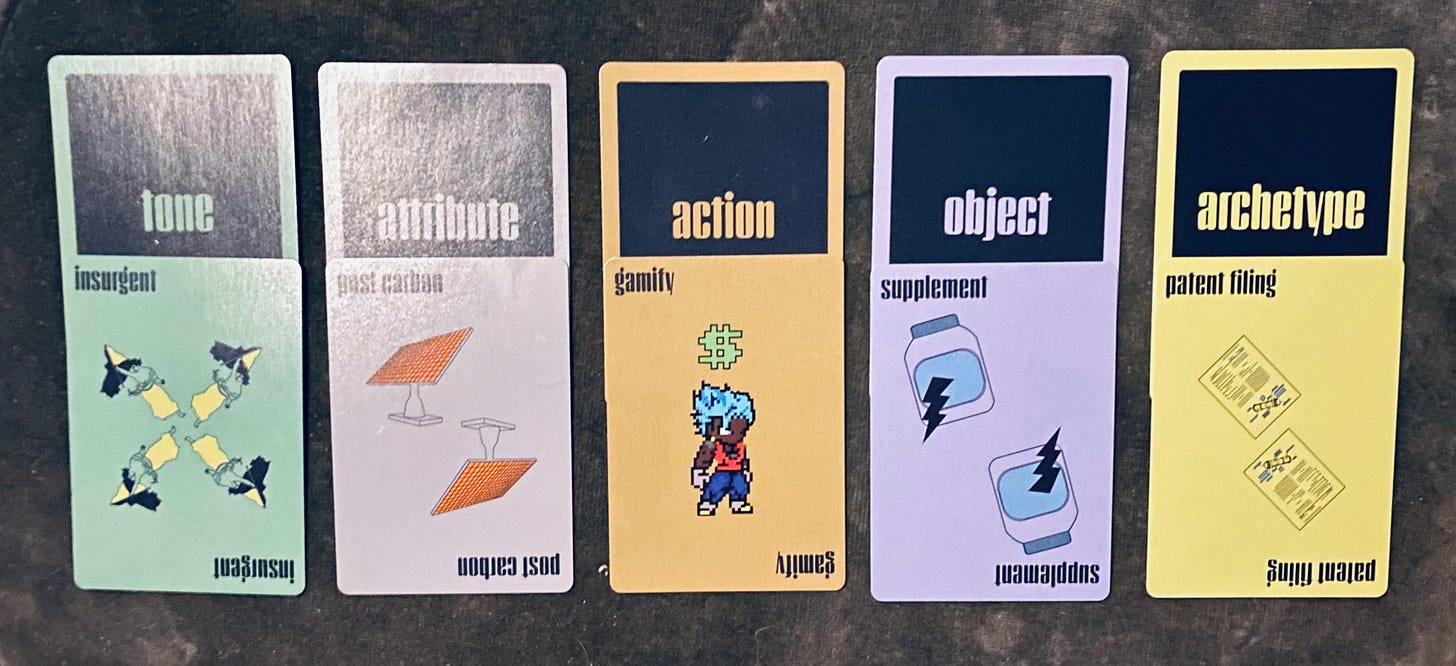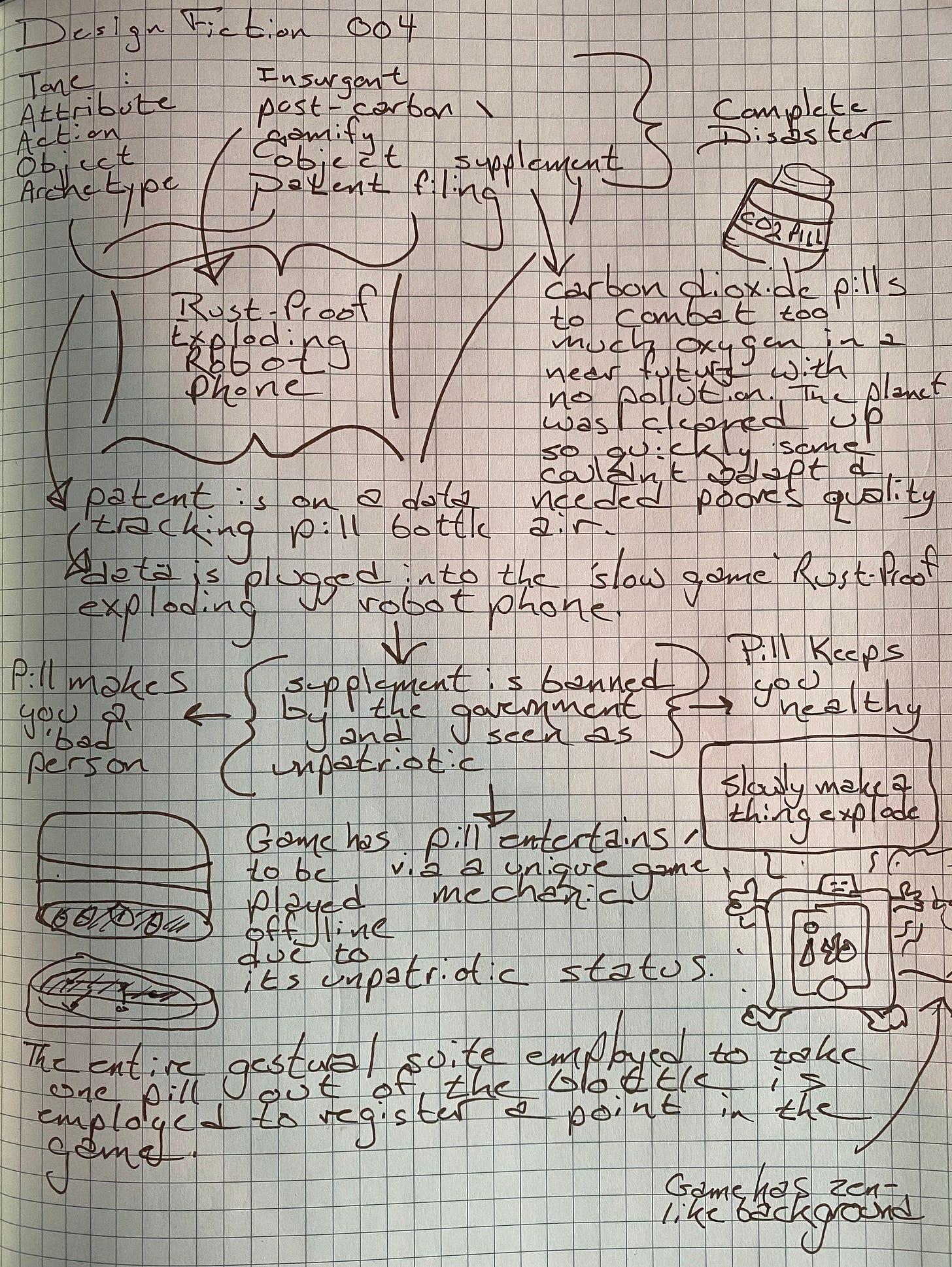Workit Wednesday 005: Gesture Tracking Medicine Bottle
Guest time traveller Drew Wiberg arrives bearing a design fiction gift.
In today’s edition of Workit Wednesday I’m riding shotgun in Drew Wiberg’s time machine. When he’s not visualizing data, sciencing information or managing knowledge, Drew can be found dumpster-diving the future for artifacts to bring to the present for us to examine and interrogate. I invited my Near Future Laboratory collaborator to show off a Design Fiction he originally posted to a Discord a couple of weeks ago.
Let’s take a look at what he’s done and chat about it.
Dre Labre: What can you tell us about these prompts? Is there any special incantation you recite prior to shuffling? Do to accept whatever you pull? Or to do pick and choose?
Drew Wiberg: I am pretty systematic about the work kit and take what I am given (much like tarot), but I take the extra step of setting aside cards that I have already used.
The chosen cards for today’s design fiction;
Archetype: Patent Filing
Object: Supplement
Action: Gamify
Attribute: Post Carbon
Tone: Insurgent
DL: With the cards laid out, tell us a little about what went through your head as you started to develop your idea.
DW: It starts with musing, sometimes for a half hour, and in the case of my next one, weeks. Then it typically is pen to paper; I prefer a squared (graph) Moleskine and a Nakabayashi Artnavi disposable fountain pen. I do save everything I do, which is why I use hardcover Moleskine for notes, easy to archive on the bookshelf.
DL: Once brainstormed, talk about your production process.
DW: I do my best to start with basics, like pen and ink, and then will often upload sketches into Vectornator to flatten and then import into Affinity designer if it needs more work. I do love making things quick and dirty and with a ‘this is the early 90s we are doing the best we can, ok?’ asthetic. It helps me recapture the feel of my creative youth, garage band industrial music, acrylic paints on found plywood, dubbing and mixing tapes with two boomboxes facing one another, graffiti art, and reams of poetry on manual typewriters.
A short interview with Drew about his approach to Design Fiction.
DL: How did you discover design fiction.
DW: I discovered design fiction through the work of a fellow Milwaukean, Coe Douglas, an amazing designer, pataphysician, and design educator in Wisconsin and beyond. We were aligned in other areas of interest so when he started recommending the Near Future Lab and producing and teaching about Design Fiction himself, I jumped on the train.
DL: How are you using design fiction? (beyond imagining harder)
DW: Prior to discovering DF I had in my head a business book for my field (knowledge management) that blended business processes, metaphor, science fiction, and storytelling. An alternative to all of the mind-numbing academic and Harvard Business School content I had to slog through to gain my own expertise. Looking for through my closet for ideas on how to achieve this, I stumbled through the coats at the back into the shimmering winter fantasy-land of DF and said to myself, ‘this is what I’ve been looking for’.
DL: Do you practice design fiction beyond the work kit?
DW: I am using work kit creations and other DF techniques, a lot centering on the curating if weak signals, to inform and drive the narrative of this work. It is a fascinating method of generating narrative arcs while embedding the lessons only futuring can teach.
DL: Tell me a bit about your process? What kind of things go on in your head when you’re working on design fiction?
DW: It all starts with pen and paper and desk research. I think through the end of my pen and the DF evolves there in front of me. Similarly the desk research into weak signals expands and contracts the scope of the DF until I find something ‘right’.
DL: What is a Design Fiction recommendation you’d like to offer our readers (could a tip, a site, a book, a movie, anything really).
DW: My recommendation, honestly, is to look at the centuries old tradition of tarot and other methods of using archetypes to explore the future. Humans have been using oracles and tarot for maybe 700 years to generate fictions and peer into the future. There is a lot of hidden alignment there and in the practice of design fiction.
Thanks to Drew Wiberg for the last-minute request to take me for a spin in his time machine. Be sure to check out his site, Ninefrontiers, where you can find more work and writing, including some flash fiction inspired by his design fiction creations.
If you made it this far, dear reader, thank you.





